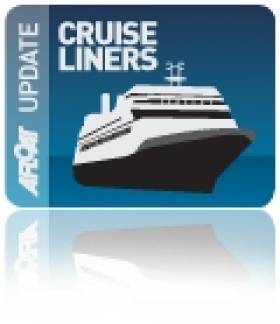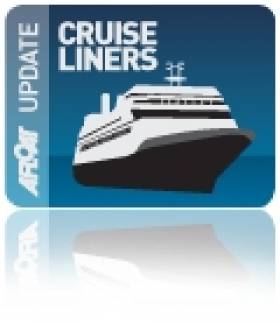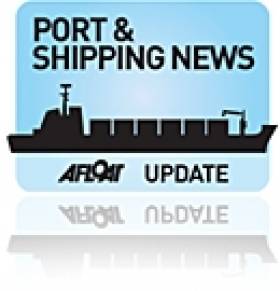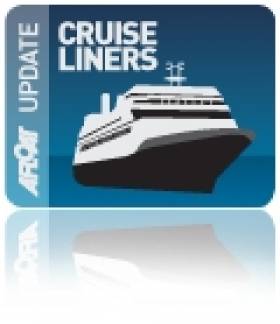Displaying items by tag: Dun Laoghaire Harbour
Cruiseship-Yacht Makes Return Visit to Dun Laoghaire Harbour
#CruiseYacht- Cruiseship-yacht Wind Surf (14,000 tonnes) with her impressive five 164-ft masts docked today in Dun Laoghaire Harbour and during the port's third cruise season, writes Jehan Ashmore.
The flagship of Windstar Cruises five-strong fleet as reported yesterday has a capacity for 310 guests and towering above her passenger decks are the masts that set seven triangular shaped computer controlled self-furling sails that total 26,000 sq m.
She sailed overnight from an anchorage call off Dunmore East and her visit to Dun Laoghaire Harbour is a fly-cruise turnaround, likewise to her two previous calls last year.
On that final visit last July during the 'heatwave', as she departed her sails were furled -out (click link for photo) which was an added bonus to those strolling the harbour piers.
Wind Surf relies mostly on engine power (hence the funnel between the second and third masts), has four Wartsila diesel-electric generating sets and a pair of electrical propulsion motors that deliver 12 knots. This can be increased by combining her sails to achieve 15 knots with a favourable wind. During joint-power operations she has a sea-water hydraulic ballast system to limit heel when sailing.
As to be expected the 187m flagship has luxurious amenities and a crew of almost 200 on board the vessel that was launched as Club Med 1 a quarter-century ago for original owners Club Med. She was last extensively renovated in 2012. Her sister was in Irish waters this week when Club Med 2 called to Cobh.
Both vessels throughout their careers have cruised mostly in the Mediterranean and Caribbean, however last year was a first for operators Wind Star and Club Med to visit Irish ports. This evening she may or not 'self-furl' her sails, but will certainly motor out of the harbour bound for Douglas, Isle of Man.
Dun Laoghaire International Sailing Events Group Set Up
#dlharbour – Dun Laoghaire Harbour Company have recently formed a local stakeholder group called Dun Laoghaire International Sailing Events, (DLISE) involving the major yacht clubs in the area, the Harbour Company, and DLRCoCo. The aim of the group, according to the Harbour company newsletter is to attract major international sailing events to the Harbour, which will 'increase the profile of the Harbour Internationally and have a positive impact on the local economy'.
#Harbours(Amendment)Bill- As previously reported the Harbours (Amendment) Bill 2014, recently announced by Minister for Transport, Tourism & Sport (DTTAS) Leo Varadkar, will allow five designated Ports of Regional Significance.
The ports designated under the bill are Drogheda, Dún Laoghaire, Galway, New Ross and Wicklow which are to transfer to local authority ownership at a future date, in line with Government policy to strengthen local government.
These five ports play an important role through tourism, leisure amenity, and regional trade. The Government has decided that their future is best secured under strong local governance.
The draft legislation builds upon Minister Varadkar's ongoing reform of the State commercial ports sector as announced in last year's National Ports Policy.
On the Department of Transport (click for website), there is a copy of the General Scheme of the Harbours (Amendment) Bill 2014 available HERE and a copy of the Regulatory Impact Analysis is also available through this LINK.
During 2013 and early 2014 the Department conducted two significant consultation phases – the first commenced in August 2013 and the second in December 2013. The draft Regulatory Impact Analyses accompanying these consultation phases together with relevant submissions can be found using the links also available on the DTTAS website page as to above links given.
Among the copies of the letters published from the five ports is the request in full for the increase to Dun Laoghaire port limits which is contained within the consultation submission letter to DTTAS.
Overnight 'Island Sky' Cruise to Dun Laoghaire Harbour to Mark Dawn of Third Cruise Season
#CruiseDunLaoghaire – Dun Laoghaire Harbour's third cruise season will begin with Island Sky, the 118 passenger vessel is sailing overnight from Waterford under command of Swedish master, Captain Karlsson, and is due in the morning, writes Jehan Ashmore.
On this Noble Caledonia operated cruise there are 87 passengers on board and she is one of four callers for the 2014 season, which is considerably less than the scheduled 14 callers last year.
Having said that Dun Laoghaire Harbour Company can look forward in welcoming the return of impressive five-masted cruiseship, Wind Surf, which twice called in 2013 and in which cruise passengers embarked at the port having flown in from the US.
The Windstar Cruise vessel as previously reported on Afloat.ie is likewise of Island Sky visiting Waterford Estuary this year, though today she headed upriver to the city quays, while the wind-assisted vessel is to anchor this summer off Dunmore East.
As for Island Sky's arrival tomorrow morning, she is to pick up a pilot from a Dublin Port cutter prior to entering Dun Laoghaire Harbour where she is to berth alongside Carlisle Pier.
She is a sister of Sea Explorer which notably arrived without passengers nor embarked, as the former Renaissance Cruises vessel went into lay-up in March 2013, prior to resuming a new career cruising in northern Europe.
The old mailboat and former conventional car-ferry terminal pier is where the immacutely painted Serenissima, a classic former Norwegian 'Hurtigruten' Harald Jarl built in 1960 became the first caller to Dun Laoghaire in 2013. She also was the first to actually dock within the harbour and on the same day saw the historic first call of Cunard Line's flagship Queen Mary 2 that anchored offshore.
This season's line-up may not be as extensive, yet Dun Laoghaire Harbour's visit of Island Sky is a first so is Seabourn Cruises luxury mega-yacht style Seabourn Legend.
Under the National Ports Policy launched last year by Minister for Transport, Leo Varadkar, Dun Laoghaire Harbour along with four other ports where classed as having 'regional significance'.
In Dun Laoghaire's case the development of the harbour is to refocus in meeting local requirements that focus on tourism, cruise liners and marine leisure activity.
#dlmarina – A year after yacht clubs reacted to a cut in Dun Laoghaire Harbour's swinging moorings, the Royal St. George, has vacated it s long held east bight moorings at the request of the Dun Laoghaire harbour Company and relcoated to the town marina.
The harbour company requires the east bight area to facilitate visiting cruise ships, a new area of revenue for the harbour.
The Royal St.George, the country's biggest club, says 'As opposed to doing a partial withdrawal over the 2014/2015 seasons we have agreed a new facility with Dun Laoghaire Marina in their West Bight section'.
It is intended that all Royal St George boats on the East Bight will relocate. Moorings in front of the club house are currently unaffected. The club says it has agreed a very favourable rate with the marina and takes into account the notified increases for mooring charges.
A launch service between the club and the Marina will be available and currently a scheduled service is being drawn up, this will be the only point of access to the West Bight.
The initial agreement between the club and the marina is for a period of 4 years.
The club website advises 'the West Bight berthing rate exclusive to RSGYC members will be €170 p/ meter vs. the Marina's advertised rate of €217.50 p/ meter' This rate is available from Lift In – Lift Out and only to RSGYC members that availed of moorings in the last few years.
For 2013 Royal St.George mooring rates were €147 p/ meter. With the increases from the Harbour Co for 2014 the rate would be in the region of €155 p/ meter, the club estimates.
The west bight marina facility will only be accessible from the RSGYC club house pontoons and will be served by the Launch Service with one pickup/ drop off point on the West Bight which will increase efficiency.
First Drive-in Cinema for Dublin at Dún Laoghaire Harbour
#drive-in Cinema – As Afloat.ie reported previously, Dún Laoghaire Harbour Company in partnership with Underground Cinema have today (13.03.2014) launched Dublin's first drive-in cinema ahead of the St. Patrick's bank holiday weekend. The Drive In is located inside the standage area of the Ferry Terminal at Dún Laoghaire Harbour.
Family favourite 'Grease' will kick off the screenings on Saturday (15.03.2014) at 7pm followed by classic thriller 'Jaws' at 9pm. There will be a further four screenings over the over the course of the weekend including:
· Back to the Future on Sunday, 16th March at 7pm
· The Usual Suspects on Sunday, 16th March at 9pm
· The Goonies on Monday, 17th March at 7pm
· The Commitments on Monday, 17th March at 9pm.
Tickets can be booked online at www.underground-cinema.com/drive-in-movies or at the Drive In on the day and each screening will take up to 80 cars. 20 pedestrian tickets are also available for each screening. On arrival, audience members check in at the Drive In and have the opportunity to order snacks including pizza from Dún Laoghaire pizzeria 'Bits and Pizzas'. Staff will then direct cars to their parking location where the audience can tune into the radio frequency displayed on the screen.
Commenting today, JP Montgomery, Dún Laoghaire Harbour Company said: "One of our key responsibilities in Dún Laoghaire Harbour Company is to maintain and enhance the recreational value of the Harbour. Bringing the first drive-in cinema to Dublin has been an exciting undertaking for us and will undoubtedly deliver a significant economic benefit to the town. The Harbour has such potential as a tourism destination and we anticipate a great level of activity over the bank holiday weekend. Ticket sales for the Drive In have been excellent with people and families coming from all over the country.
Four screenings are planned for the end of March as well as further screenings later in the year. March screenings include:
· Despicable Me 2 on Saturday, 29th March at 7pm.
· Alien on Saturday, 29th March at 9pm.
· Monsters University on Sunday, 30th March at 7.45pm
· Casablanca on Sunday, 30th March 30th at 9.45pm
Has Dun Laoghaire Lost the Plot?
#dlharbour – Dun Laoghaire's waterfront area and harbour is a hotbed of development and proposed projects. W M Nixon takes an outsider's view of what might be happening around Ireland's biggest sailing centre.
Your heart would go out to Dun Laoghaire. The perceptions which emerge from proposals for developments and new businesses along the waterfront definitely don't chime at all with the image of a place which once was known as Kingstown, and has its origins in the heights of gentility and middle class refinement.
What are we folk from other ports to make of it all? We find sailing in through the entrance to savour Dun Laoghaire harbour's unique style a wonderful experience. There is nowhere quite like it, not just in Ireland, but anywhere else in the world. Yet rumours fly around about changes which could seriously impair the special character of the place. What are those of us who may not have the inside track on the true nature of actual and anticipated developments along the waterfront to make of it all?
Not to pull the punches, it seems that the Dun Laoghaire waterfront area is going to have an enlarged halting site for the Travelling community down towards the west pier. It's going to have an "urban beach" resort amenity for the sort of people who use such places within the harbour on the inner end of the east pier, thereby blocking off a very useful berthing space. And it's going to have the Dublin area's first Wetherspoon's super-pub right bang in the middle of the harbourside.
Set against Dun Laoghaire history and the elegant appearance of its better buildings, this would all seem bad enough. But that is to ignore the most enormous elephant in the room. This is the new public library, which has been put up with astonishing speed to block out much of the sea view from the Royal Marine Hotel. It towers over the entire waterfront with a prow which suggests that at last Ireland has her first aircraft carrier. But unfortunately for any strategic purposes and rapid peace-keeping in distant parts of the world, it happens to be very landbound in the midst of mostly pleasant smaller buildings which now seem utterly dwarfed.

It's behind you!!!........ The new Dun Laoghaire library looms over everything on the waterfront. Yet if you're in the National YC (foreground) and looking out to sea, you don't know it's there. Photo: W M Nixon
It would indeed be wonderful if it were an aircraft carrier and could put to sea and leave the town to nurture something of its own true character. But instead we have to learn to live with it while wondering what it's all about, though in fairness it should be mentioned that the first notions of it were to provide a structure to match the sky-scraping Daniel Liebeskind building (remember that?) which once upon a time was planned for the Carlisle Pier just across the way.
But if this is indeed a public library, then we can only conclude that the good people of Dun Laoghaire must do an awful lot of reading, for it's HUGE. And we can only fear that if they read with the assiduity this building suggests, then they'll have neither time nor energy for anything else, not even the seagoing pursuits which the possession of one of the finest artificial harbours in the world should encourage.
From Dun Laoghaire's traditional promenading area of the East Pier, the new library building towers in particular over the National Yacht Club. Of course, if you're in that most hospitable club and looking out to sea, you're blissfully unaware of this enormous presence behind you. But the effect on people coming in from seaward is distinctly oppressive - it's like that giant black space craft which hovered over New York in the movie Independence Day.

Dun Laoghaire in the rare ould times, when you'd a real sea view from the Royal Marine Hotel, and from the pier could admire that splendid establishment in all its glory. Photo courtesy NYC.
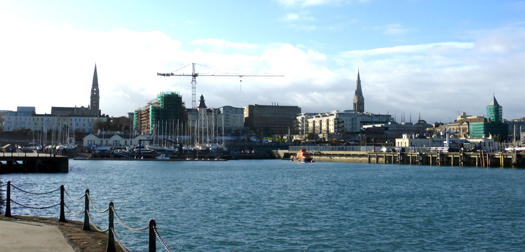
The same section of waterfront today. Is this progress? Photo: W M Nixon
Until this thing appeared, there were still some relics of ould decency and architectural harmony along the Dun Laoghaire waterfront and the streets immediately behind it. Any significant building is a statement in itself, so we're entitled to look at buildings as they are, and respond to them. The central gem of the waterfront is the railway station, designed by John Skipton Mulvany. It's a perfect little jewel of neo-classical design, and to my mind makes a much pleasanter architectural statement than that other exercise in classical work, the Casino at Marino, which was fussily built as an architectural exercise, whereas Dun Laoghaire station is both functional and beautiful, well fulfilling its contemporary role as a stylish restaurant.
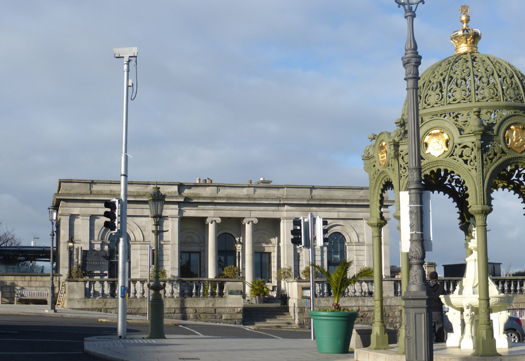
Dun Laoghaire's Mulvany-designed station is a gem. Photo: W M Nixon
Dun Laoghaire did very well out of John Skipton Mulvany, as in 1851 he created the design for the Royal Irish Yacht Club building. In terms of Irish history, few buildings are so significant in the very fact and timing of their construction. Originally founded in 1831, the Royal Irish had been overshadowed by its brasher younger sister, the Royal St George YC founded 1838. While the George developed rapidly as the exclusive preserve of the land-owning classes and the most prosperous Protestant business magnates – the offspring of Cromwellian land-grabbers and the Jamesons and Guinnesses, in other words – the RIYC, as a club with some of the older traditions in its makeup, went into a decline which was accelerated by the grievous effects of the Great Famine from 1845 onwards.
Thus when a meeting of several RIYC members – their numbers including Daniel O'Connell the Liberator - was held in a Dublin hotel on 4th July 1846 (American Independence Day by design, one presumes), it was in the hope that the club could be revived as an expression of faith in the future, and they agreed that a new landmark building on the waterfront would be the key to this.
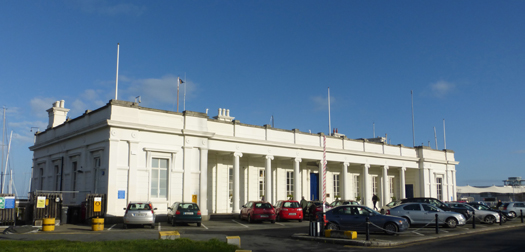
The landward side of the Royal Irish YC. With the undeveloped nature of the waterfront, the architect had to design a building which presented a proper facade on all fronts. Photo W M Nixon
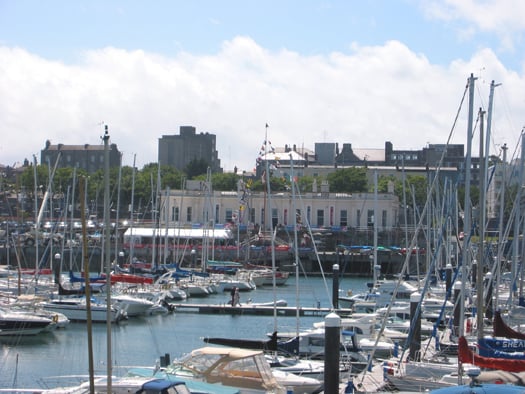
The Royal Irish YC seen across the marina. Built 1851, it is the world's oldest complete purpose-designed yacht club building. Photo: W M Nixon
So in responding to the RIYC's impressive neo-classical pavilion on the harbour, we are looking at both the world's first complete purpose-built yacht club house, and the very symbol of a nation beginning the long road to recovery from both the Famine and centuries of conquest and despoliation.
Along the waterfront, the Royal St George clubhouse by contrast was built through frequent expansions, but as Mulvany was also involved in some of the stages, it has a fine sense of completeness despite its several creators in different eras. Facing up to the challenge of matching these two classical buildings on the waterfront to the west was clearly an insuperable task, so when the National Yacht Club came into being as the Edward Yacht Club in 1870, it went for a much more under-stated architectural style. There's something attractively of the shooting and fishing lodge of the west of Ireland about it, it seems modest by comparison with the other two clubhouses, yet it's surprisingly roomy and stylish within.

Although it was built in several stages, today the Royal St George YC presents a complete appearance, and it preserves its sense of identity despite the encroachment of much taller modern buildings nearby. Photo: David O'Brien
All three of the big waterfront clubhouses are immaculately maintained and each brings its own injection of vitality – and substantial employment – to Dun Laoghaire. And the town in turn has developed in concert with the growth of maritime activity, and the increased communication with Dublin brought about by the historic railway (which was opened in 1834) and frequent road improvements, while summertime excursion steamers sailed to the harbour from Dublin port.
Some would compare the stylish seaside town for Dublin which tried to develop at Dun Laoghaire with Brighton in its relationship with London. But Brighton was purely a seaside resort in which the recent marina is an add-on, it's not a harbour which is central to the place. Dun Laoghaire by contrast is all about the harbour. There was virtually nothing there until this vast asylum and ferry harbour for large vessels (that was its sole original purpose) was built on a totally empty bit of coastline eastward of the old Dunleary harbour, a shallow tidal inlet which it enclosed and whose existence is remembered in the area's local name The Gut.
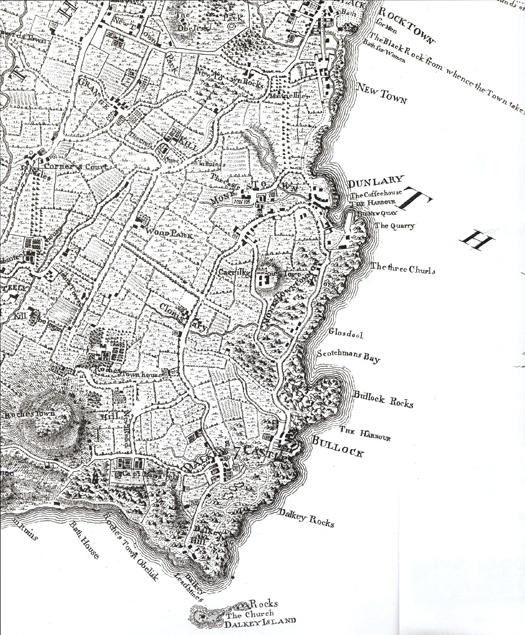
The coast at Dun Laoghaire before the harbour was built. The harbour of Old Dunleary, in the area still known as The Gut, was a shallow creek in the southwest corner of the new harbour.

First plan for the new harbour in 1817. The entrance was made wider in the finished version, and the West Pier was built further west to enclose the Old Dunleary harbour
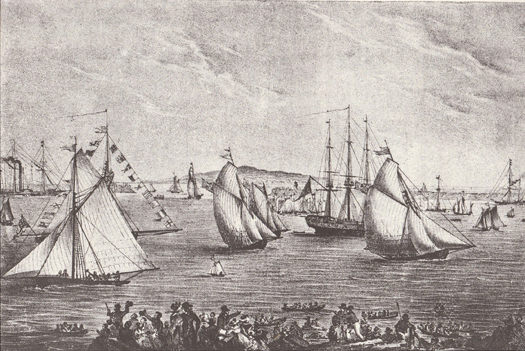
The first regatta in the new harbour was sailed on July 22nd 1828, and was won by Liberty (on right, 39 tons, owner Lord Errol) from Medora (45 tons, owner Mr Kelly). The Royal Irish YC emerged in 1831 from this event.

The yachtsman's Dun Laoghaire today, as shown in the ICC Sailing Directions. Courtesy Irish Cruising Club
Thus it may be stretching it a bit, but the most telling comparison for Dun Laoghaire's aspirations might well be Trieste on the Adriatic. In the glory days of the Austro-Hungarian Empire, Trieste was Vienna-on-Sea. The distance from the capital may have been enormous by comparison with the short hop from Dublin out to Dun Laoghaire. But Emperors – even ancient Hapsburg ones – could move mountains and shorten apparent distance, and they could ensure that the distance to Trieste was no barrier to the place having a Viennese atmosphere, style and sense of place.
Those who find such an idea crazy might like to remember that your man Von Trapp, he of Sound of Music fame, was in real life an officer in the post–imperial Austrian Navy. Trieste was for real. So in a sense if we wanted to see what Dun Laoghaire in its burgeoning Kingstown days was trying to become, just think of it as Official & Ceremonial Dublin-on-Sea. Thus the buildings tried to be slightly miniaturised versions of impressive buildings of government in the city itself, and for a while they succeeded.

The Town Hall gets the attention it deserves. Photo: W M Nixon
The Town Hall, for instance, is a delight – to me it speaks as a restrained exercise in Italianate Victorian, and were it facing onto a proper town square, we really would have a space to celebrate. And just along from it in the town in its glory days was the unsullied façade of the Royal Marine Hotel. French chateau, I would say, and all the better for it. But another enjoyer of architecture was suggesting the other night that there was more than a hint of the south German schloss in it, so we agreed that it was either French or German depending on which country had won the most recent little war over Alsace and Lorraine.
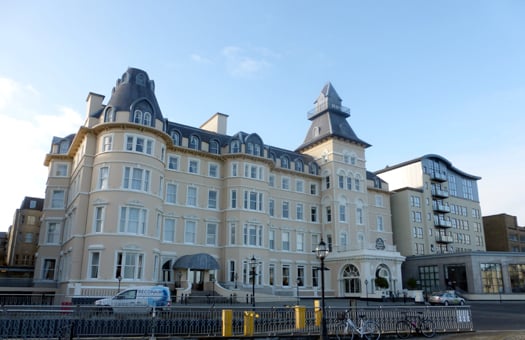
The Royal Marine Hotel has a distinctive style which unfortunately was not replicated in the extension on the right, which was added several decades ago. Photo: W M Nixon
Whatever, the Dun Laoghaire waterfront at the height of the late Victorian-Edwardian era really was quite something. There were several different styles of architecture, but mostly they were good examples of their type, and all respected each other. It had a sense of completeness which harmonised with the harbour. But since then we seem to have lost the plot. Is there an element of disliking the built symbols of the past, and therefore sticking up something which is effectively a deliberate affront?
Perhaps it's just that architects are scared stiff of being accused of producing new buildings, or extensions to buildings, which are merely pastiches of what went before, despite the fact that the general public seem more than happy with a good pastiche. And surely it's better to have a good pastiche than a bad bit of pseudo-modern design which clashes with everything about it?
Thus the harmonious Dun Laoghaire waterfront of a century ago, as seen from within the harbour or down the piers, is now giving out conflicting messages which dampen the sense of welcome for those entering the port. The stately Royal Marine Hotel, a bit pretentious in its day perhaps, but nevertheless true to itself, was given an addition on its western side which, unusually, still hasn't mellowed in – it continues to look like a bad example of architecture from a particularly poor period.
As for that wonderful Town Hall, the office block added down one side is better than the addition to the Royal Marine, but it has lost the opportunity to make a statement of harmony on the building's north side facing across to the railway station. And as for what could have been a town square in front of the Town Hall (for which we argued in favour in several issues of Afloat magazine a very long time ago) that was filled with the Pavilion Development which, while built with quality materials, has never seemed to quite know what it is supposed to be doing. You could scarcely claim it to be a runaway commercial success, and as ever in Dublin, it was the residential part of the project which provided the real motor for the exercise.
But those residential blocks in turn intruded on the vital miniature parkland and garden in front of the Royal Marine Hotel. Now that glorious sea view from the Royal Marine is being further impaired by the new library. In fact, "impaired" is scarcely the word. The Royal Marine doesn't really have a sea view any more at all, in the sense that rooms at the front had a view clear out into the open waters of St George's Channel. Strictly speaking, all that the Royal Marine can now look forward to is a harbour and bay view, which is rather different. Much better than many Dublin hotels, perhaps, but a poor thing by comparison with the wide nautical vistas of the past.

Artists's computerised impression of how the view of the Royal Marine hotel will look once the new library (left) is completed
As for this new library, doubtless in the architectural trade it will be seen as an impressive use of new materials, and it will be pointed out how skilfully it has been fitted into a narrow space. But the computer-generated impressions of the finished building show something a little too like a Belfast peace wall to bring joy to the heart, and on its east side – the hidden side looming over many residential properties – they seem to be utilising rather a lot of nasty red brick, something which is otherwise almost entirely unused anywhere else on the Dun Laoghaire waterfront.
But while the new library may seem to roar at its neighbours and loom threateningly over them, not every new development along the Dun Laoghaire waterfront provokes hostility. For instance, the new Irish lights headquarters is so good of its type that it greatly enhances the area. And as for the Ferry Terminal, "reasonably good of its sort" might be the kindest response. Something had to be provided to give a positive architectural response to the very new-style HSS ferries, and when there's one in port it's sometimes difficult to tell where ship ends and ferry terminal begins, which is as it should be.
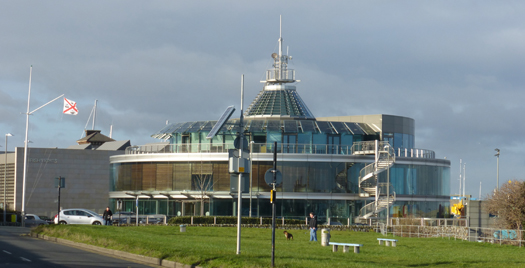
It just shows what you can do by really trying, and being brave. The impressive Irish Lights headquarters building. Photo: W M Nixon
But the era of very high speed ferries may be drawing to a close, as the shipping companies gravitate towards a new generation of ships which may not be so utterly fast, but are much quicker than the boats the HSS replaced, and provide a level of on-board comfort which makes the little extra time aboard slip easily by.
With economy measures now totally dominant, the lower berthing prices and much greater available berthing options offered by Dublin Port offset the fact the driving through the hinterland of the Port to the ferry terminals is not really a joyous urban experience. Most car-ferry passengers are prepared to tolerate a level of urban and sub-industrial blight in order to get cheap fares and frequency of service.
But where the ferries move away as they appear to be doing from Dun Laoghaire, it seems the cruise liners want to move in. The cruise liners currently can berth alongside in Dublin Port, but have to lie off in Dublin Bay if they want to send their passengers directly by tender into Dun Laoghaire. But for the cruise liners and their guests, the prospect of Dun Laoghaire becoming a proper cruise liner port is positively mouth-watering.
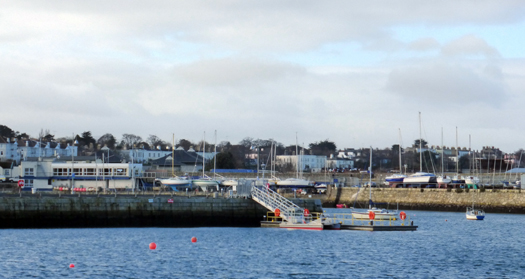
At the moment, the only access the passengers on large cruise liners have to Dun Laoghaire is via the ship's tenders to this landing pontoon in the Inner Harbour. Photo: W M Nixon
For when it fulfils its potential, Dun Laoghaire is a place of style and fun, an ideal up-market cruise liner destination. Simply being there in a luxurious cruise liner would be enough in itself on a sunny day with the harbour and waterfront alive with people enjoying themselves. And the ready access to Dublin itself, and the Garden of Ireland in Wicklow, is all a bonus.
But such perfection won't come cheap. For sure, if it comes to fruition the Dun Laoghaire Harbour Masterplan of two years ago, indicating a large cruise liner berth to the west of the present ferry terminal, would indeed provide the Harbour Company with a golden source of income. But whether that income can be transferred onwards to traders in the town is another matter.
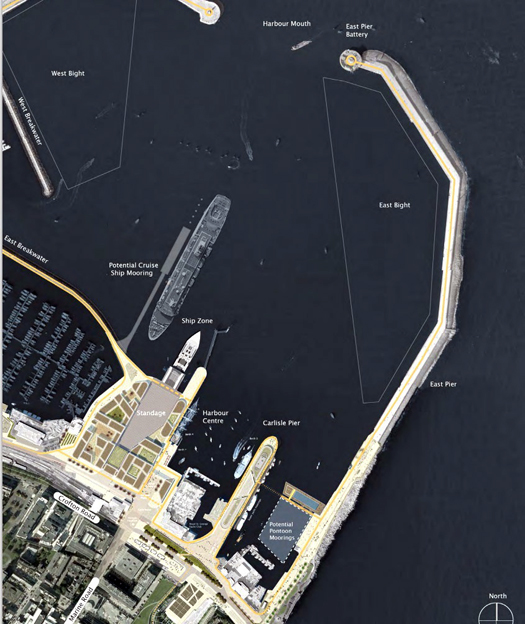
The initial plan of two years ago for a Cruise Liner berth within Dun Laoghaire Harbour. While it will restrict some sailing and boating space within the harboiur, new space will be created by the removal of the moorings in the East Pier bight. Note the proposed swimming pool indicated at the time at right angles to the East Pier off the National YC (bottom right) with marina berths within a new breakwater.
Cruise liner passengers are notorious for seeking complete packages beforehand. Thus when they arrive in port they expect shore visits to be part of the deal, and they prefer to move in pre-paid groups ashore, rather than move individually and spend some money in the town. So those who would expect across-the-board benefit may be disappointed. They may find that the cruise liner seen as the goose that lays the golden does indeed squat down, almost taking over the entire harbour, and it does indeed lay a golden egg. But that golden egg is only a fat berthing fee for the harbour company and hire fees for some bus company. Beyond that, expenditure can very limited.
Yet there's no denying the real money that be made out of berthing fees, and that of course will percolate into the town in the form of wages for extra waterfront staff. Who knows, they may even have to find a crew for a designated Dun Laoghaire harbour tug or two, though a state-of-the-art cruise liner is computer controlled by a single joystick activating thrusters working every which way, and it's amazing the spaces they can access without tugboat aid. That said, in the event of a rare summertime nor'east gale, you could sell tickets for the end of the pier to watch a giant liner getting out.
But this is all way in the future, though with every step in the economic recovery, that future is accelerating in its approach. For the moment, we can be sure that markers are being put down for future harbour use, and the word is that all the swinging moorings in the east bight of the harbour are going to be cleared, presumably to allow eventual manoeuvring space within that part of the harbour for liners. As that space will be empty when no liner is moving, its possible availability will partly compensate for the inevitable loss of sailing and boating space within the harbour, which is a proper concern of Water Wag sailors, inshore rowing clubs, and the increasing number of sailing schools.
A newer line on the grapevine has it that one of the yacht clubs outside the current marina, currently concerned about members losing those mooring in the eastern bight, has negotiated exclusive rights for its members to the stand-alone marina pontoons in the northwest part of the harbour inside the northern marina breakwater, those berths to be accessed by a regular ferry service from the club in question.
While seeing the logic of this, it would put paid to a crazy little notion of mine. Until this new allocation arose, it had seemed to me that there was potential for a completely new club, with its headquarters way down the West Pier where it meets outer marina breakwater. This new club would have its own direct access to that northwest part of the marina. The wild West Pier – which some would like to se as a kind of nature reserve – has ample room for both a roadway to this new clubhouse, and the existing walkway right out to the lighthouse. It would be one of the few clubs in Ireland to be south-facing, and its location would certainly provide that sense of being away from it all which is supposed to be what going sailing is all about.
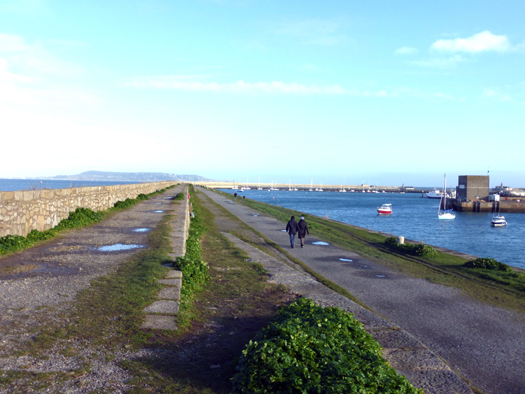
The wild West Pier. Were it needed, there is plenty of space for both a walkway and a roadway. Photo: W M Nixon
But that little daydream is now gone with the likelihood of a rapid ferry service from a club to the northwest Marina pontoons. Meanwhile, back in the real world, what is happening to preserve or destroy Dun Laoghaire's unique ambience which will, it's hoped, encourage Cruise Liner Companies to fork out mega-bucks to berth there?
If you look carefully at the Masterplan, you'll see that in front of the National YC there's a blue pool indicated at right angles to the East Pier. At the time, this was envisaged as a swimming pool and lido area in a vast barge, and it seemed a reasonable idea, as within it there were indicated new marina berths within convenient reach of the club.
But a recent planning application by the Harbour Company has put a different spin on all this. The new "urban beach" will be on a floating structure paralleling the East Pier alongside that handy berthing area on the East Pier. A cost of €2.5 million is being quoted as the capital expenditure needed to create this new facility, and the spokesmen for the harbour company are confident it will attract enough high-paying customers to pay off the initial cost while covering the significant running costs.
That's as may be, but this large intrusion into valuable berthing space is also a matter of concern for those who have been campaigning long and hard for the restoration of the nearby disused Dun Laoghaire Baths, which are outside the harbour area and therefore wouldn't reduce any valuable berthing space. But in any case they're in a deplorable state of dilapidation, a danger and an eyesore, so some action is urgently needed. There's a Public Meeting on today (Saturday January 25th) about all this in the Kingston Hotel in Dun Laoghaire at 3.0pm, and it will be interesting to hear what people think about the old baths in relation to the proposed new urban beach.
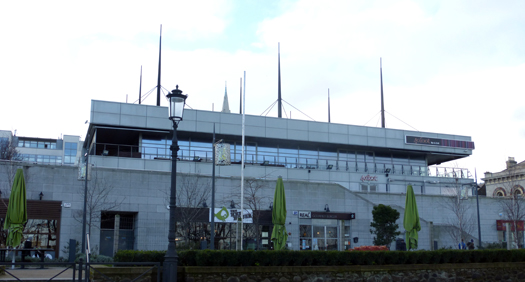
The English pub chain J D Wetherspoon have indicated their intention of opening in the former Forty Foot premises on the top of the Pavilion. Photo: W M Nixon
We move along the waterfront to the Pavilion, and the former Forty Foot pub. It's as near as certain going to be the Dublin area's first J D Wetherspoon pub. You'll have heard of them as the people in England who already have a chain of 900 pubs, and have just opened the first ever pub at motorway service area, which one would have thought unthinkable, but such seems to be the case. Anyway, big chief Tim Martin and his efficient team running this outfit have decided the time is now ripe to move into Ireland with its many post-Tiger era bankrupted bars.
And they make no secret of their intentions. Their ideal location, they say, is large premises in a strongly working class area. Good for them, you say, but who on earth reckons Dun Laoghaire to be a strongly working class area? Well, 900 successful pubs across England can't be wrong. And it could well be what the Pavilion needs to come to life, even if it's not quite what posh passengers on a cruise liner might expect. But as for resentment that an English pub chain is moving into Ireland, the reality is that your favourite local, after a tricky time emerging from the aftermath of the boom years, is now probably owned by a German bank anyway.
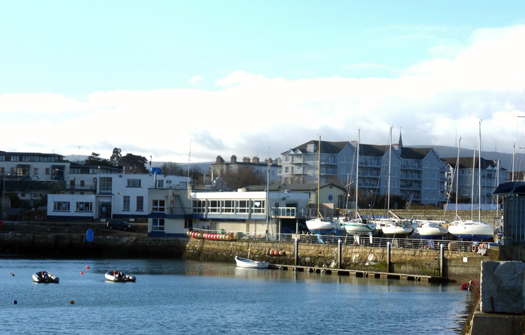
It's one very crowded little spot already. The Dun Laoghaire Motor Yacht Club, the Coastguard, and the Irish National Sailing School are among those crowded into the southwest corner of the harbour where a new Halting Site is also planned. Photo: W M Nixon
Concluding with our third opening point, the proposed new halting site towards the West Pier is a tricky one. That corner of the harbour has a small long-established site, presumably the new one will be much bigger. And things are already very crowded down there with the Dun Laoghaire Motor Yacht Club on the sea side of the little quayside street, and the premises of the Irish National Sailing School, the Irish Coastguard and others across the narrow road.
The business of Traveller Halting Sites is a difficult one, but doubtless Dun Laoghaire can cope in its own way. After all, the harbour area already has several locations which look after the needs of people who have immediate access to unexpectedly large sums of ready money, people who also have a strange taste for drinking alcohol in the open air even when the weather is atrocious, people moreover who enjoy moving about all the time in uncomfortably confined damp spaces in close proximity with like-minded ruddy-faced folk. It's just that they're not called Halting Sites. They're called Yacht Clubs.
Dun Laoghaire Harbour Company CEO Gerry Dunne responds to this article here.
Dun Laoghaire's Wild West Pier Has Them Foxed
#dlharbour – Locals like to think of Dun Laoghaire's West Pier as being like a bit of Ireland's Atlantic seaboard, rugged and untamed in contrast to the smooth expression of urban order which is the East Pier.
This week, while researching the western half of the harbour for the Sailing on Saturday blog which will feature Dun Laoghaire developments in detail on January 25th, we found dramatic evidence that this is where the wild things are. A fox was strolling along beside the inner harbour as easy as you please.
But in fact, meeting the fantastic Mr Fox was evidence of the urban nature of the entire harbour. And it's encouraging for those who like to think of Dun Laoghaire as Ireland's Brighton. Apparently, Brighton is reckoned fox paradise in the south of England. It has a population of at least twenty foxes per square kilometre. And that's not counting the two-legged ones who run the many antique shops and art galleries...

Are you really sure the road is clear?
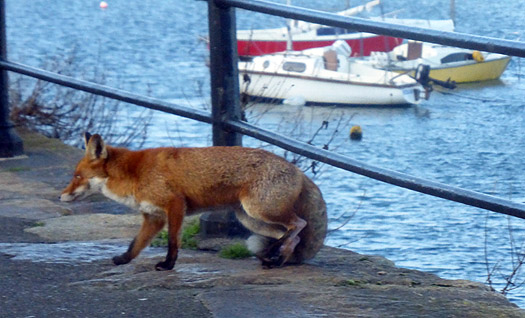
We'll just hang out here, and pretend to be interested in that Leisure 17
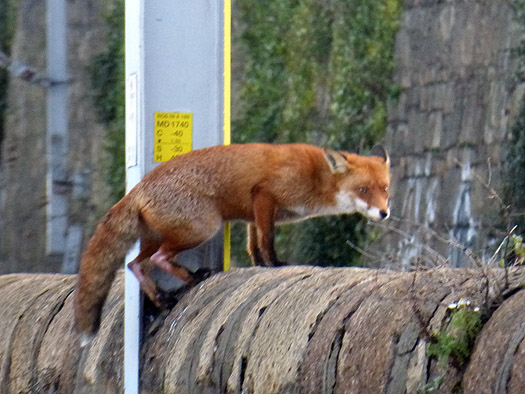
This place is getting too crowded with the wrong sort of people. Time to get in the right side of the tracks. All photos W M Nixon
Click here for the blog by WM Nixon featuring Dun Laoghaire developments
Not Quite the Full Pint as Further Tanks Arrive for Guinness Plant
#GuinnessTanks - Loaded with fermentation tanks for Guinness, Thamesteel I (1989/1,984grt) picked up a pilot in Dublin Bay as she approached Dun Laoghaire Harbour this evening, writes Jehan Ashmore.
It transpires that this extra shipment of the stainless steel fermentation tanks weighing up to 30 tons each are required for the €153m plant upgrade at the Guinness St. James's Gate Brewery facility in central Dublin.
Thamesteel I had sailed from Rotterdam-Maasvlakte from where previous shipments were discharged by a trio of cargoship's earlier this year, the last been Blue Tune which called to Dun Laoghaire Harbour in March.
On this occasion, the Marshall Islands flagged vessel which features a telescopic wheelhouse was raised due to the large cylindrical tanks positioned as deck cargo on the cargo hatch covers.
She berthed at Carlisle Pier from where the pilot was transferred back to the Camac, a Dublin Port pilot cutter built by Cork Harbour based Safehaven Marine.
Dun Laoghaire Harbour to Appoint Consultants for New Cruise Berths
#NEWCruiseBerths - Dún Laoghaire Harbour Company, acting on behalf of the Dún Laoghaire Cruise Stakeholder Group, are to appoint a Multi-disciplinary Consultancy Team for the provision of cruiseship facilities.
The proposed facilities are to attract cruisehips to make a port of call in this developing market which forms as a key element of the Dún Laoghaire Harbour Masterplan.
As reported yesterday, the new chairperson of Dun laoghaire Harbour Company board, Eithne Scott Lennon, has been an active member of the board since 1994 and played a significant role in the development of the Masterplan.
The Multi-disciplinary Consultancy Team is to provide professional services in order to carry out all planning and preliminary engineering design for the required new berth and supporting facilities.
In addition consultants are required to prepare the planning application and accompanying EIS, and to manage the planning consenting process through to completion.
For further information regarding the Cruise Berth Project Brief (download the PDF) or visit www.etenders.gov.ie


























